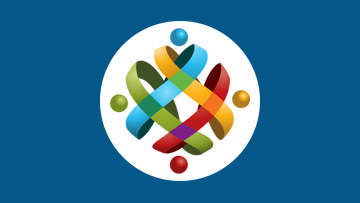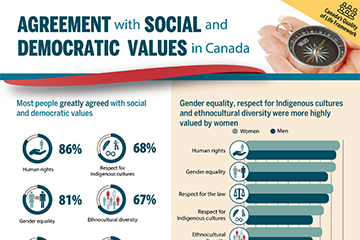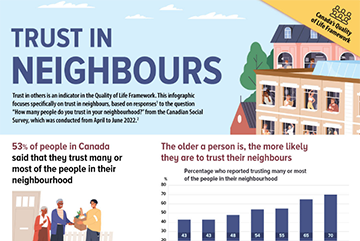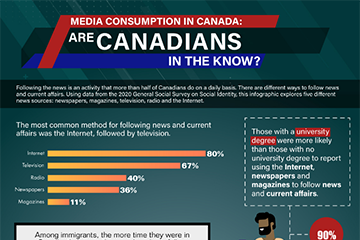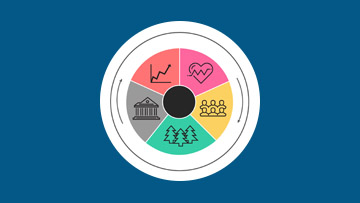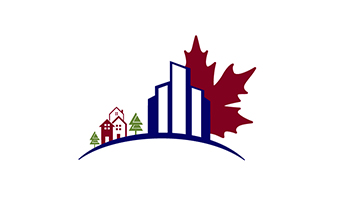Labour Market and Socio-economic Indicators
In July 2024, the following questions measuring the Labour Market and Socio-economic Indicators were added to the Labour Force Survey as a supplement.
The purpose of this survey is to identify changing dynamics within the Canadian labour market, and measure important socio-economic indicators by gathering data on topics such as type of employment, quality of employment, support payments and unmet health care needs.
Questionnaire flow within the collection application is controlled dynamically based on responses provided throughout the survey. Therefore, some respondents will not receive all questions, and there is a small chance that some households will not receive any questions at all. This is based on their answers to certain LFS questions.
Labour Market and Socio-economic Indicators
ENTRY_Q01 / EQ 1 - From the following list, please select the household member that will be completing this questionnaire on behalf of the entire household.
LMI_Q01 / EQ 2 What forms of payment [do/does] [you/respondent name/this person] receive in [your/his/her/their] main job or business?
Select all that apply.
- A wage or salary
e.g., hourly, weekly, annual
- Piece rate
- Commissions
e.g., percentage of a sale
- Tips
- Bonus or performance pay
- Charges or fees for services
e.g., taxi fares, fees charged for legal or professional services
- Based on profit
Any other situation where earnings are based on revenue or the financial performance of a business
Include profit based on revenue, as well as dividends, profit sharing, stock options
- Other
- Unpaid work
LMI_Q02 / EQ 3 - What is the main form of payment in [your/his/her/their] main job or business?
Would you say:
- A wage or salary
e.g., hourly, weekly, annual
- Piece rate
- Commissions
e.g., percentage of a sale
- Tips
- Bonus or performance pay
- Charges or fees for services
e.g., taxi fares, fees charged for legal or professional services
- Based on profit
Any other situation where earnings are based on revenue or the financial performance of a business
Include profit based on revenue, as well as dividends, profit sharing, stock options
- Other
- Unpaid work
LMI_Q03 / EQ 4 - You previously mentioned that [you/respondent name/this person] [is/are] self-employed in [your/his/her/their] main job.
Over the last 12 months, was at least 50% of [your/Respondent’s name/this person’s] main business activity reliant on:
A single client
A client is the user of the good or service sold by the business
A website or app that matches [you/respondent name/this person] with clients or potential clients
e.g., Amazon, Uber, UpWork, AirBnB, SkiptheDishes
Another company or person subcontracting tasks or projects
A single supplier
i.e., of raw materials, supplies or goods for resale
An agency, broker or other type of intermediary
LMI_Q04 / EQ 5 - Which of these relationships is most important for [your/Respondent’s name/this person’s] main business?
- A single client
A client is the user of the good or service sold by the business
- A website or app that matches [you/respondent name/this person] with clients or potential clients
e.g., Amazon, Uber, UpWork, AirBnB, SkiptheDishes
- Another company or person subcontracting tasks or projects
- A single supplier
i.e., of raw materials, supplies or goods for resale
- An agency, broker or other type of intermediary
LMI_Q05 / EQ 6 - Does this [main client/website or app/company or person/supplier/agency, broker or other type of intermediary]:
Directly determine [your/Respondent’s name/this person’s] schedule
- To a large extent
- To some extent
- Not at all
- Does not apply
Directly control how [your/respondent name/this person] organize[s] or conduct[s] [your/his/her/their] work
- To a large extent
- To some extent
- Not at all
- Does not apply
Directly set the price of the product or service
- To a large extent
- To some extent
- Not at all
- Does not apply
Provide the tools or software required to run the business
e.g., a vehicle, an app to connect with clients, power tools
- To a large extent
- To some extent
- Not at all
- Does not apply
Provide the materials required to run the business
e.g., raw materials, supplies, goods for resale
- To a large extent
- To some extent
- Not at all
- Does not apply
LMI_Q08 / EQ 7 - As part of [your/his/her/their] main business, could [your/Respondent name/this person] hire paid help if [you/he/she/this person] wanted to delegate some tasks?
- Yes
- No, not allowed to delegate tasks as part of the arrangement with the [main client/website or app/company or person/supplier/agency, broker or other type of intermediary]
- No, does not currently have the financial resources
- No, for some other reason
LMI_Q11 / EQ 8 - In [your/his/her/their] main job, [do/does] [you/respondent name/this person] have a written agreement or an oral agreement with [your/his/her/their] employer?
- Written contract or agreement
e.g., letter of offer, contract, written agreement, other documentation
- Oral contract or agreement
LMI_Q12 / EQ 9 - In [your/Respondent’s name/this person’s] main job, does [your/his/her/their] employer contribute to Employment Insurance (EI) on [your/Respondent’s name/this person’s] behalf?
- Yes
- No
- Don’t know
IMM_Q01 / EQ 10 - [Is/Are] [you/respondent name/this person] a Canadian citizen?
- Yes
- No
IMM_Q02 / EQ 11 - When did [you/respondent name/this person] first come to Canada to live?
Was it:
- Less than 1 year ago
- 1 year ago to less than 5 years ago
- 5 years ago to less than 10 years ago
- 10 years ago to less than 15 years ago
- 15 years ago or longer
IMM_Q03 / EQ 12 - How old [were/was] [you/respondent name/this person] when [you/he/she/this person] first came to Canada to live?
Select year of age
IML_Q01 / EQ 13 - What type of permit [do/does] [you/respondent name/this person] currently hold?
Is it:
- Work permit only
- Study permit only
- Work and study permit
- Other
IML_Q02 / EQ 14 - [Do/Does] [you/respondent name/this person] plan to apply for permanent residence in Canada?
- Yes
- No
- Undecided
- Don’t know
IML_Q03 / EQ 15 - Since [you/respondent name/this person] first came to Canada to live, how many paid jobs or businesses [have/has] [you/he/she/this person] had?
Is it:
- None
- 1
- 2
- 3 to 5
- 6 or more
IML_Q04 / EQ 16 - What is the highest certificate, diploma, or degree that [you/respondent name/this person] [have/has] completed outside Canada prior to [your/his/her/their] arrival?
- High school diploma or less
- Trades certificate or diploma
- College, CEGEP or other non-university certificate or diploma (other than trades certificates or diplomas)
- University certificate or diploma below the bachelor’s level
- Bachelor’s degree
e.g., B.A., B.A. (Hons), B.Sc., B.Ed., LL.B.
- University certificate, diploma or degree above the bachelor’s level
IML_Q05 / EQ 17 - What was the major field of study of the highest certificate, diploma or degree that [you/respondent name/this person] completed outside Canada prior to [your/his/her/their] arrival?
Major field of study of [trades certificate or diploma/college, CEGEP or other non-university certificate or diploma/university certificate or diploma below the bachelor’s level/bachelor’s degree/university certificate, diploma or degree above the bachelor’s level]:
IML_Q06 / EQ 18 - In what country did [you/respondent name/this person] obtain this certificate, diploma, or degree?
Please select the country from the dropdown menu below. Type the first few letters to narrow down the choices.
IML_Q07 / EQ 19 - Did an assessment agency or a government department grant [you/respondent name/this person] an equivalency assessment of credentials obtained outside Canada for [your/his/her/their] highest certificate, diploma, or degree?
- Yes
- No, never applied
- No, [your/Respondent’s name/this person’s] application was rejected
- In the process of finding out
IML_Q08 / EQ 20 - Before coming to Canada, how many years of work experience related to the highest diploma, certificate or degree [you/respondent name/this person] obtained outside Canada did [you/he/she/this person] accumulate?
Is it:
- None
- Less than a year
- 1 to less than 5 years
- 5 to less than 10 years
- 10 years or more
IML_Q09 / EQ 21 - Since [your/Respondent’s name/this person’s] arrival in Canada, did [you/he/she/they] ever get a paid job that was related to the highest diploma or degree [you/he/she/they] obtained outside Canada?
- Yes, a job entirely related to [your/his/her/their] highest diploma or degree
- Yes, a job partially related to [your/his/her/their] highest diploma or degree
- No, applied but never got it
- No, never applied
- Don’t know
IML_Q10 / EQ 22 - Considering the very first job related to [your/Respondent’s name/this person’s] highest diploma or degree, to what extent were [your/his/her/their] years of experience obtained outside Canada considered to determine the characteristics of the position?
Was it:
- Most of [your/his/her/their] professional experience obtained outside Canada was considered
- Only a part of [your/his/her/their] professional experience obtained outside Canada was considered
- None of [your/his/her/their] professional experience obtained outside Canada was considered
IML_Q11 / EQ 23 - For which of the following reasons [have/has] [you/respondent name/this person] never applied to a paid job related to the highest diploma or degree [you/he/she/this person] obtained outside Canada?
Select all that apply.
- No jobs available in the area
- Education was not recognized
- Did not know how to proceed
- Believed that very few immigrants get their experience accepted
- Did not think it was worth it
- Financial pressures
- Wanted to work in a different field or do something different
- Other
Specify
IML_Q12 / EQ 24 - [Have/Has] [you/respondent name/this person] ever attempted to obtain a license or a technical credential to practice a regulated occupation from a professional association or a regulatory body in Canada?
- Yes, based on foreign credentials, experience or education
- Yes, but only based on Canadian credentials, experience or education
- No
IML_Q13 / EQ 25 - Did the professional association or regulatory body accept [your/Respondent’s name/this person’s] foreign credentials or experience to practice a regulated occupation in Canada?
- Yes, fully
e.g., no further courses were required
- Yes, partly
e.g., further courses or training were needed
- No
- Results of application are still pending
- Don’t know
IML_Q14 / EQ 26 - Did [you/respondent name/this person] have any problems or difficulties finding [your/his/her/their] current main job or starting [your/his/her/their] current main business?
- Yes
What main problem or difficulty did [you/respondent name/this person] experience as part of finding [your/his/her/their] current main job or starting [your/his/her/their] current main business?
Select all that apply.
- Language-related difficulties
- Did not know the steps needed to apply for a job
e.g., filling job applications, writing a resume, preparing for interviews, etc.
- Difficulty accessing job postings
e.g., Internet access issues, did not know what websites to use
- Did not know the steps to start a business
e.g., permits, accounting, financing, etc.
- Qualifications from outside Canada were not accepted
- Job experience from outside Canada was not accepted
- Not enough job experience or references in Canada
- Few jobs in what [your/Respondent’s name/this person’s] [were/was] trained in
- No connections in the job market
- Discrimination
- Transportation
- Other
Specify
- No
IML_Q15 / EQ 27 - What languages are required to perform the main tasks or duties of [your/Respondent’s name/this person’s] current main job or business?
Select all that apply.
Is it:
- English
- French
- Other language
OR
- No language requirements
IML_Q16 / EQ 28 - How do the required language skills in English at [your/Respondent’s name/this person’s] current main job or business compare to [your/his/her/their] current language skills?
Is it:
- [Your/Respondent’s name/This person’s] job requires higher language skills
- [Your/Respondent’s name/This person’s] job matches [your/his/her/their] current language skills
- [Your/Respondent’s name/This person’s] job requires lower language skills
IML_Q17 / EQ 29 - How do the required language skills in French at [your/respondent’s name/this person’s] current main job or business compare to [your/his/her/their] current language skills?
Is it:
- [Your/Respondent’s name/This person’s] job requires higher language skills
- [Your/Respondent’s name/This person’s] job matches [his/her/their/your] current language skills
- [Your/Respondent’s name/This person’s] job requires lower language skills
IML_Q18 / EQ 30 - After [you/respondent name/this person] arrived in Canada, how long did it take for [you/him/her/them] to find [your/his/her/their] first paid job or start [your/his/her/their] first business?
Is it:
- Job found before migration
OR
Less than 3 months
- 3 to less than 6 months
- 6 to less than 12 months
- 12 months to less than 2 years
- 2 years to less than 4 years
- 4 years or more
IML_Q19 / EQ 31 - How did [you/respondent name/this person] obtain [your/his/her/their] first paid job?
Select all that apply.
- Applied for the job directly from abroad
- Recruited by an employer directly from abroad
- Helped by a friend or a family member outside Canada
- Helped by a friend or a family member inside Canada
- Helped by a sponsor
- On a previous stay
- Transferred by company
- Other
OR
- Not applicable
e.g., only worked as a self-employed-worker
IML_Q20 / EQ 32 - Did [you/respondent name/this person] have any problems or difficulties finding [your/his/her/their] first job or starting [your/his/her/their] first business in Canada?
- Yes
What main problem or difficulty did [you/respondent name/this person] experience as part of finding [your/his/her/their] first job or starting [your/his/her/their] first business?
Select all that apply.
- Language-related difficulties
- Did not know the steps needed to apply for a job
e.g., filling job applications, writing a resume, preparing for interviews, etc.
- Did not know the steps to start a business
e.g., permits, accounting, financing, etc.
- Difficulty accessing job postings
e.g., Internet access issues, did not know what websites to use
- Qualifications from outside Canada were not accepted
- Job experience from outside Canada was not accepted
- Not enough job experience or references in Canada
- No jobs in what [you/respondent name/this person] [were/was] trained in
- No connections in the job market
- Discrimination
- Transportation
- Other
Specify
- No, [you/respondent name/this person] did not have any difficulties
- No, [you/respondent name/this person] [have/has] never looked for work
SCC1_Q05 / EQ 33 - In the last 12 months, did [you/Respondent name] receive support payments from a former spouse or partner?
SCC1_Q10 / EQ 34 - What is your best estimate of the amount of support payments [you/he/she/this person] received in the last 12 months?
SCC2_Q05 / EQ 35 - In the last 12 months, did [you/Respondent name] make support payments to a former spouse or partner?
SCC2_Q10 / EQ 36 - What is your best estimate of the total amount [you/he/she/this person] paid in support payments in the last 12 months?
SCC3_Q05 / EQ 37 - In the last 12 months, did [you/Respondent name] pay for child care, so that [you/he/she/this person] could work at a paid job?
SCC3_Q10 / EQ 38 - What is your best estimate, of the total amount [you/he/she/this person] paid for child care in the last 12 months?
DSQ_Q01 / EQ 39 - [Do/Does] [you/Respondent name] have any difficulty seeing?
- No
- Sometimes
- Often
- Always
- Don’t know
DSQ_Q02 / EQ 40 - [Do/Does] [you/he/she/this person] wear glasses or contact lenses to improve [your/his/her/their] vision?
DSQ_Q03 / EQ 41 - [With [your/his/her/their] glasses or contact lenses, which] of the following best describes [your/Respondent’s name] ability to see?
- No difficulty seeing
- Some difficulty seeing
- A lot of difficulty seeing
- [You/He/She/This person] [are/is] legally blind
- [You/He/She/This person] [are/is] blind
- Don’t know
DSQ_Q04 / EQ 42 - How often does this [difficulty seeing/seeing condition] limit [your/his/her/their] daily activities?
- Never
- Rarely
- Sometimes
- Often
- Always
- Don’t know
DSQ_Q05 / EQ 43 - [Do/Does] [you/Respondent name] have any difficulty hearing?
- No
- Sometimes
- Often
- Always
- Don’t know
DSQ_Q06 / EQ 44 - [Do/Does] [you/Respondent name/this person] use a hearing aid or cochlear implant?
DSQ_Q07 / EQ 45 - [With [your/his/her/their] hearing aid or cochlear implant, which/Which] of the following best describes [your/respondent’s name] ability to hear?
- No difficulty hearing
- Some difficulty hearing
- A lot of difficulty hearing
- [You/He/She/This person] cannot hear at all
- [You/He/She/This person] [is/are] Deaf
- Don’t know
DSQ_Q08 / EQ 46 - How often does this [difficulty hearing/hearing condition] limit [your/his/her/their] daily activities?
- Never
- Rarely
- Sometimes
- Often
- Always
- Don’t know
DSQ_Q09 / EQ 47 - [Do/Does] [you/Respondent name] have any difficulty walking, using stairs, using [your/his/her/their] hands or fingers or doing other physical activities?
- No
- Sometimes
- Often
- Always
- Don’t know
DSQ_Q10 / EQ 48 - How much difficulty [do/does] [you/he/she/this person] have walking on a flat surface for 15 minutes without resting?
- No difficulty
- Some difficulty
- A lot of difficulty
- [You/He/She/This person] cannot do at all
- Don’t know
DSQ_Q11 / EQ 49 - How much difficulty [do/does] [you/he/she/this person] have walking up or down a flight of stairs, about 12 steps without resting?
- No difficulty
- Some difficulty
- A lot of difficulty
- [You/He/She/This person] cannot do at all
- Don’t know
DSQ_Q12 / EQ 50 - How often [does this difficulty walking/does this difficulty using stairs/do these difficulties] limit [your/his/her/their] daily activities?
- Never
- Rarely
- Sometimes
- Often
- Always
- Don’t know
DSQ_Q13 / EQ 51 - How much difficulty [do/does] [you/Respondent name] have bending down and picking up an object from the floor?
- No difficulty
- Some difficulty
- A lot of difficulty
- [You/He/She/This person] cannot do at all
- Don’t know
DSQ_Q14 / EQ 52 - How much difficulty [do/does] [you/he/she/this person] have reaching in any direction, for example, above [your/his/her/their] head?
- No difficulty
- Some difficulty
- A lot of difficulty
- [You/He/She/This person] cannot do at all
- Don’t know
DSQ_Q15 / EQ 53 - How often [does this difficulty ending down and picking up an object/does this difficulty reaching/do these difficulties] limit [your/his/her/their] daily activities?
- Never
- Rarely
- Sometimes
- Often
- Always
- Don’t know
DSQ_Q16 / EQ 54 - How much difficulty [do/does] [you/Respondent name] have using [your/his/her/their] fingers to grasp small objects like a pencil or scissors?
- No difficulty
- Some difficulty
- A lot of difficulty
- [You/He/She/This person] cannot do at all
- Don’t know
DSQ_Q17 / EQ 55 - How often does this difficulty using [your/his/her/their] fingers limit [your/his/her/their] daily activities?
- Never
- Rarely
- Sometimes
- Often
- Always
- Don’t know
DSQ_Q18 / EQ 56 - [Do/Does] [you/Respondent name] have pain that is always present?
DSQ_Q19 / EQ 57 - [Do/Does] [you/he/she/this person] [also] have periods of pain that reoccur from time to time?
DSQ_Q20 / EQ 58 - How often does this pain limit [your/his/her/their] daily activities?
- Never
- Rarely
- Sometimes
- Often
- Always
- Don’t know
DSQ_Q21 / EQ 59 - When [you/Respondent name] [is/are] experiencing this pain, how much difficulty [do/does] [you/he/she/they] have with [your/his/her/their] daily activities?
- No difficulty
- Some difficulty
- A lot of difficulty
- [You/He/She/This person] cannot do most activities
- Don’t know
DSQ_Q22 / EQ 60 - [Do/Does] [you/Respondent name] have any difficulty learning, remembering or concentrating?
- Never
- Sometimes
- Often
- Always
- Don’t know
DSQ_Q23 / EQ 61 - Do you think [you/Respondent name] [have/has] a condition that makes it difficult in general for [you/him/her/them] to learn? This may include learning disabilities such as dyslexia, hyperactivity, attention problems, etc.
DSQ_Q24 / EQ 62 - Has a teacher, doctor or other health care professional ever said that [you/Respondent name] had a learning disability?
DSQ_Q25 / EQ 63 - How often are [your/his/her/their] daily activities limited by this condition?
- Never
- Rarely
- Sometimes
- Often
- Always
- Don’t know
DSQ_Q26 / EQ 64 - How much difficulty [do/does] [you/Respondent name] have with [your/his/her/their] daily activities because of this condition?
- No difficulty
- Some difficulty
- A lot of difficulty
- [You/He/She/This person] cannot do most activities
- Don’t know
DSQ_Q27 / EQ 65 - Has a doctor, psychologist or other health care professional ever said that [you/Respondent name] had a developmental disability or disorder? This may include Down syndrome, autism, Asperger syndrome, mental impairment due to lack of oxygen at birth, etc.
DSQ_Q28 / EQ 66 - How often are [your/Respondent’s name] daily activities limited by this condition?
- Never
- Rarely
- Sometimes
- Often
- Always
- Don’t know
DSQ_Q29 / EQ 67 - How much difficulty [do/does] [you/Respondent name] have with [your/his/her/their] daily activities because of this condition?
- No difficulty
- Some difficulty
- A lot of difficulty
- [You/He/She/This person] cannot do most activities
- Don’t know
DSQ_Q30 / EQ 68 - [Do/Does] [you/he/she/this person] have any ongoing memory problems or periods of confusion?
DSQ_Q31 / EQ 69 - How often are [your/his/her/their] daily activities limited by this problem?
- Never
- Rarely
- Sometimes
- Often
- Always
- Don’t know
DSQ_Q32 / EQ 70 - How much difficulty [do/does] [you/Respondent name] have with [your/his/her/their] daily activities because of this problem?
- No difficulty
- Some difficulty
- A lot of difficulty
- [You/He/She/This person] cannot do most activities
- Don’t know
DSQ_Q33 / EQ 71 - [Do/Does] [you/Respondent name] have any emotional, psychological or mental health conditions?
- No
- Sometimes
- Often
- Always
- Don’t know
DSQ_Q34 / EQ 72 - How often are [your/his/her/their] daily activities limited by this condition?
- Never
- Rarely
- Sometimes
- Often
- Always
- Don’t know
DSQ_Q35 / EQ 73 - When [you/he/she/Respondent name] [is/are] experiencing this condition, how much difficulty [do/does] [they/you/he/her] have with [your/his/her/their] daily activities?
- No difficulty
- Some difficulty
- A lot of difficulty
- [You/He/She/This person] cannot do most activities
- Don’t know
DSQ_Q36 / EQ 74 - [Do/Does] [you/Respondent name] have any other health problem or long-term condition that has lasted or is expected to last for six months or more?
DSQ_Q37 / EQ 75 - How often does this health problem or long-term condition limit [your/his/her/their] daily activities?
- Never
- Rarely
- Sometimes
- Often
- Always
- Don’t know
DSQ_Q38 / EQ 76 - [Do/Does] [you/Respondent name] have pain that is always present?
DSQ_Q39 / EQ 77 - [Do/Does] [you/he/she/this person] [also] have periods of pain that reoccur from time to time?
DSQ_Q40 / EQ 78 - How often does this pain limit [your/his/her/their] daily activities?
- Never
- Rarely
- Sometimes
- Often
- Always
- Don’t know
DSQ_Q41 / EQ 79 - When [you/Respondent name] [is/are] experiencing this pain, how much difficulty [do/does] [you/he/she/they] have with [your/his/her/their] daily activities?
- No difficulty
- Some difficulty
- A lot of difficulty
- [You/He/She/This person] cannot do most activities
- Don’t know
UCN_Q05 / EQ 80 - During the past 12 months, was there ever a time when [you/Respondent name] felt that [you/he/she/they] needed health care, other than homecare services, but [you/he/she/they] did not receive it?
UCN_Q10 / EQ 81 - Thinking of the most recent time [you/Respondent name] felt this way, why didn’t [you/he/she/they] get care?
- Care not available in the area
- Care not available at time required (e.g. doctor busy, away from office or no longer at that practice, inconvenient hours)
- Do not have a regular health care provider
- Waiting time too long
- Appointment was cancelled
- Felt would receive inadequate care
- Cost
- Decided not to seek care
- Doctor didn't think it was necessary
- Transportation issue
- Other
UCN_Q15 / EQ 82 - Again, thinking of the most recent time, what was the type of care that was needed?
- Treatment of a chronic physical health condition diagnosed by a health professional
- Treatment of a chronic mental health condition diagnosed by a health professional
- Treatment of an acute infectious disease (e.g., cold, flu and stomach flu)
- Treatment of an acute physical condition (non-infectious)
- Treatment of an acute mental health condition (e.g., acute stress reaction)
- A regular check-up (including pre-natal care)
- Care of an injury
- Dental care
- Medication / Prescription refill
- Other
UCN_Q20 / EQ 83 - Did [you/he/she/this person] actively try to obtain the health care that was needed?
UCN_Q25 / EQ 84 - Where did [you/he/she/this person] try to get the service [you/he/she/they] [were/was] seeking?
- A doctor’s office
- A hospital outpatient clinic
- A community health centre [or CLSC]
- A walk-in clinic
- An emergency department or emergency room
- Other


 Cannabis
Cannabis Civic participation
Civic participation Coronavirus
Coronavirus Rural Canada
Rural Canada Social and personal networks
Social and personal networks Sex, gender and sexual orientation
Sex, gender and sexual orientation Time use
Time use Volunteering and donating
Volunteering and donating